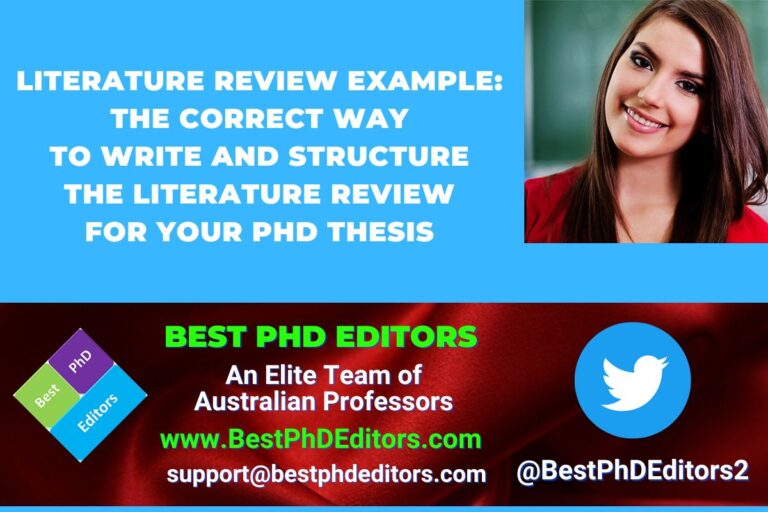
Literary Review: A Comprehensive Guide with Easy Examples

What is Literary Review?
The term “literary review” is commonly known as a “literature review” in academic writing. A literature review is an important component of a PhD thesis as it provides a comprehensive overview of the existing research and knowledge on a particular topic. This article serves as a comprehensive guide for PhD students on how to write a thorough and effective literary review. It covers all the key elements that should be included in a literature review, such as the introduction, research question, search methods, analysis and categorization, synthesis, evaluation of the literature, and conclusions. With this guide, PhD students will be able to effectively conduct a literature review and present a well-structured and comprehensive analysis of the existing research on their topic.
An Introduction to Literature Review
A literature review is a critical evaluation of the existing research on a specific topic. It is a necessary component of a PhD thesis and provides a comprehensive overview of the current state of knowledge on a topic, as well as highlighting any gaps in the existing research that your study aims to fill. In this article, we will discuss how to write a comprehensive literature review for your PhD thesis, including the structure and key elements, and provide several examples to illustrate the concepts discussed.


Structure of a Literature Review
A well-structured literature review typically includes the following sections:
Introduction: This section sets the context for the review and provides background information on the topic.
Research question: This section defines the research question that the literature review aims to address.
Search methods: This section describes the methods used to search for relevant literature, such as academic databases, journals, books, and reports.
Analysis and categorization: This section involves analysing and categorising the literature found in the search, grouping similar studies together based on their findings, methods, and contributions to the field.
Synthesis: This section summarizes and synthesizes the key findings and contributions of the studies that you have grouped together, highlighting any patterns or themes that emerge.
Evaluation of the literature: This section evaluates the quality of the literature reviewed, considering factors such as methodology, sample size, and validity of results.
Conclusions: This section summarizes the key findings of the literature review and highlights any gaps in the existing research that your study aims to fill.
We strongly recommend exploring our expert guide on structuring a literature review
Examples of Literature Review
Now let us give you a couple of literature review examples to help you understand how to write a good literary review for your PhD thesis.


Literature Review Example 1
The topic of the literature review is ‘Sustainable Energy Practices in Small and Medium-Sized Enterprises (SMEs) in the UK’.
Introduction: The introduction section provides context and background information on the topic of sustainable energy practices in SMEs in the UK. It describes the increasing importance of sustainable energy practices in addressing global environmental challenges and the need for SMEs to adopt such practices to reduce their carbon footprint. The introduction sets the stage for the review by highlighting the significance of the topic and providing a clear research question.
Research Question: The research question for this literature review is: “What are the key challenges faced by small and medium-sized enterprises in adopting sustainable energy practices in the UK?”
Search Methods: The search methods section describes the steps taken to search for relevant literature. This includes searching academic databases such as JSTOR and Scopus, reading journals and conference proceedings in the field of sustainability and energy, and reviewing relevant books and reports. The search methods section also includes a discussion of the criteria used to select relevant studies, such as their relevance to the research question, their publication date, and their quality.
Analysis and Categorization: The analysis and categorization section involves reading each source carefully, taking notes, and grouping similar studies together based on their findings, methods, and contributions to the field. In this case, studies on sustainable energy practices in SMEs in the UK could be grouped into categories based on the type of energy practice being studied (e.g. solar, wind, or geothermal), the size of the enterprise, or the region of the UK.
Synthesis: The synthesis section summarizes and synthesizes the key findings and contributions of the studies that have been grouped together. It highlights any patterns or themes that emerge from the literature, such as a general lack of understanding of the benefits of sustainable energy practices and the challenges faced by SMEs in accessing funding and support for such initiatives. The synthesis section provides a clear and concise overview of the current state of knowledge on the topic.
Evaluation of the Literature: The evaluation of the literature section evaluates the quality of the studies reviewed, considering factors such as the methodology used, the sample size, and the validity of the results. This section is crucial in ensuring that the literature review is robust and provides a solid foundation for the PhD thesis. Factors such as the validity of the data, the representativeness of the sample, and the reliability of the methods used should all be considered when evaluating the literature. This section helps to establish the strengths and weaknesses of the existing research, allowing the PhD student to build on what has been done before and identify areas for future research.
Conclusions: The conclusions section summarizes the key findings of the literature review and highlights any gaps in the existing research that the PhD thesis aims to fill. This section should clearly state the key contributions of the literature review to the field, as well as the implications for future research. It is also important to note any limitations of the literature review, such as the lack of available studies in a specific area or the difficulty in finding relevant sources. The conclusions section should provide a clear and concise summary of the key insights gained from the literature review, and demonstrate the importance of the PhD thesis in advancing the field.

Literature Review Example 2
The topic of the literature review is ‘The Effectiveness of Mindfulness-Based Interventions in the Treatment of Depression’.
Introduction: The introduction section provides context and background information on the topic of mindfulness-based interventions in the treatment of depression. It describes the increasing popularity of mindfulness-based interventions as a treatment option for depression and the need for further research to establish their effectiveness. The introduction sets the stage for the review by highlighting the significance of the topic and providing a clear research question.
Research Question: The research question for this literature review is: “What is the current evidence for the effectiveness of mindfulness-based interventions in the treatment of depression?”
Search Methods: The search methods section describes the steps taken to search for relevant literature. This includes searching academic databases such as PubMed and PsychINFO, reading journals and conference proceedings in the field of psychology and mental health, and reviewing relevant books and reports. The search methods section also includes a discussion of the criteria used to select relevant studies, such as their relevance to the research question, their publication date, and their quality.
Analysis and Categorization: The analysis and categorization section involves reading each source carefully, taking notes, and grouping similar studies together based on their findings, methods, and contributions to the field. In this case, studies on mindfulness-based interventions in the treatment of depression could be grouped into categories based on the type of intervention (e.g. mindfulness-based stress reduction, mindfulness-based cognitive therapy), the sample size, or the population being studied (e.g. adults, children, older adults).
Synthesis: The synthesis section summarizes and synthesizes the key findings and contributions of the studies that have been grouped together. It highlights any patterns or themes that emerge from the literature, such as the overall effectiveness of mindfulness-based interventions in reducing symptoms of depression and the importance of delivering these interventions in a supportive and structured environment. The synthesis section provides a clear and concise overview of the current state of knowledge on the topic.
Evaluation of the Literature: The evaluation of the literature section evaluates the quality of the studies reviewed, considering factors such as the methodology used, the sample size, and the validity of the results. This section is crucial in ensuring that the literature review is robust and provides a solid foundation for the PhD thesis. Factors such as the validity of the data, the representativeness of the sample, and the reliability of the methods used should all be considered when evaluating the literature. This section helps to establish the strengths and weaknesses of the existing research, and provides a clear picture of the gaps in knowledge that need to be addressed through future research. The evaluation of the literature also highlights the limitations of the existing research and helps to identify areas where further research is needed.
Conclusion: The conclusion section draws together the main findings of the literature review and highlights the key points. It provides a clear summary of the current state of knowledge on the effectiveness of mindfulness-based interventions in the treatment of depression, and highlights the strengths and weaknesses of the existing research. The conclusion also highlights the importance of future research in this area, particularly in addressing the gaps in knowledge identified in the evaluation of the literature section. The conclusion should provide a clear and concise summary of the literature review, and should provide the reader with a clear understanding of the current state of knowledge on the topic.
In conclusion, writing a literary review or literature review is an essential part of conducting research for a PhD thesis. By following the structure and steps outlined in this article, PhD students can effectively organize and present their review of the existing literature on their research topic. It is important to remember to critically evaluate the quality of the literature and to provide a clear synthesis of the key findings and contributions. A well-structured and comprehensive literature review provides a solid foundation for the PhD thesis and demonstrates the researcher’s knowledge and understanding of the existing research in the field.
If you’ve found our guide on literary reviews helpful, you should also check out an expert tutorial article on How to Do a Literature Search for your PhD thesis.
To complement your understanding of literary reviews, explore our comprehensive PhD Literature Review Writing Services or Dissertation Methodology Writing Services for expert help from esteemed Australian professors.
Suggested Readings for PhD Students
How to Write a Successful PhD Proposal for Australian Universities: Learn with Examples
Writing a Successful PhD Proposal for UK Universities: Tips and Examples
PhD Proposal Examples: Uncovering the Secrets to a Winning Proposal
NVIVO: A Step-by-Step Guide to The Data Analysis Software
NVIVO Coding: A Step-by-Step Tutorial
9 Easy Examples of Qualitative Data in Research
Dissertation Methodology Examples for PhD: Methodology Writing Made Easy
Dissertation Methodology Writing Decoded: Learn the Steps with Easy Examples
Binary Logistic Regression in SPSS: Learn the Steps with Easy Examples
Multiple Linear Regression using SPSS: Learn with Easy Examples





Pingback: Literature Review Example: The Correct Way To Write And Structure The Literature Review For Your PhD Thesis